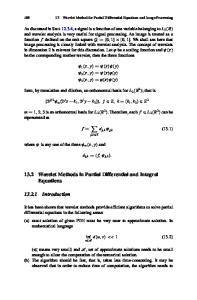Numerical solutions of fractional delay differential equations using Chebyshev wavelet method
- PDF / 895,311 Bytes
- 13 Pages / 439.37 x 666.142 pts Page_size
- 2 Downloads / 327 Views
(2019) 38:195
Numerical solutions of fractional delay differential equations using Chebyshev wavelet method Umar Farooq1 · Hassan Khan1 · Dumitru Baleanu2,3
· Muhammad Arif1
Received: 4 March 2019 / Revised: 6 August 2019 / Accepted: 24 September 2019 © SBMAC - Sociedade Brasileira de Matemática Aplicada e Computacional 2019
Abstract In the present research article, we used a new numerical technique called Chebyshev wavelet method for the numerical solutions of fractional delay differential equations. The Caputo operator is used to define fractional derivatives. The numerical results illustrate the accuracy and reliability of the proposed method. Some numerical examples presented which have shown that the computational study completely supports the compatibility of the suggested method. Similarly, a proposed algorithm can also be applied for other physical problems. Keywords Fractional-order differential equations · Chebyshev wavelet method · Caputo operator Mathematics Subject Classification 65L05
1 Introduction In nature, many physical are modeled with the help of differential equations. Some of these problems are more complex and cannot be modeled by simple differential equations. For
Communicated by José Tenreiro Machado.
B
Dumitru Baleanu [email protected] Umar Farooq [email protected] Hassan Khan [email protected] Muhammad Arif [email protected]
1
Department of Mathematics, Abdul Wali Khan University Mardan (AWKUM), Mardan, Pakistan
2
Department of Mathematics, Faculty of Arts and Sciences, Cankaya University, 06530 Ankara, Turkey
3
Institute of Space Sciences, Magurele-Bucharest, Romania
123
195
Page 2 of 13
U. Farooq et al.
these complex and non-local issues, the researchers have developed a new technique which is known as Fractional Differential Equations (FDEs). FDEs have achieved the attraction of scientists, due to its numerous applications in reallife sciences and engineering problems, such as electrolyte polarization (Deng and Li 2005), electrochemistry of corrosion (Oldham 1983), optics and signal processing (Baskin and Iomin 2013), electro-thermo elasticity (Machado et al. 2011), circuit systems (Hartley et al. 1995), diffusion wave (Bhrawy and Zaky 2015), heat conduction (Povstenko 2009) fluid flow (Kulish and Lage 2002; Mainardi 1997), probability and statistics (Kilbas et al. 2006; Bapna and Mathur 2012), and control theory of dynamical systems (Rossikhin and Shitikova 1997). The Delay Differential Equations (DDEs) have the numerous properties everywhere, particularly, Fractional Differential Equations (FDEs) with delay argument are interesting topics for its applications in certain processes and systems in engineering and other sciences (Kuang et al. 1993a; 1993b; Smith 2011; Ruan and Wei 2003; Hartung et al. 2006; Shakeri and Dehghan 2008; Yi et al. 2007). For modeling, FDDEs have gained more attention of the mathematicians for modeling as compared to simple ODEs, because a little delay has great impact. FDDEs are used in many areas of mathematics, su
Data Loading...











